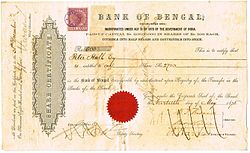| Formerly | Bank of Calcutta |
|---|---|
| Industry | Banking, financial services |
| Founded | 2 June 1806 |
| Defunct | 27 January 1921 |
| Fate | Merged with Bank of Bombay and Bank of Madras |
| Successor | Imperial Bank of India |
| Headquarters | Calcutta, Bengal Presidency , |
Area served | British India |

The Bank of Calcutta (a precursor to the present State Bank of India) was founded on 2 June 1806, mainly to fund General Arthur Wellesley's wars against Tipu Sultan and the Marathas. It was the tenth oldest bank in India and was renamed Bank of Bengal on 2 January 1809.
